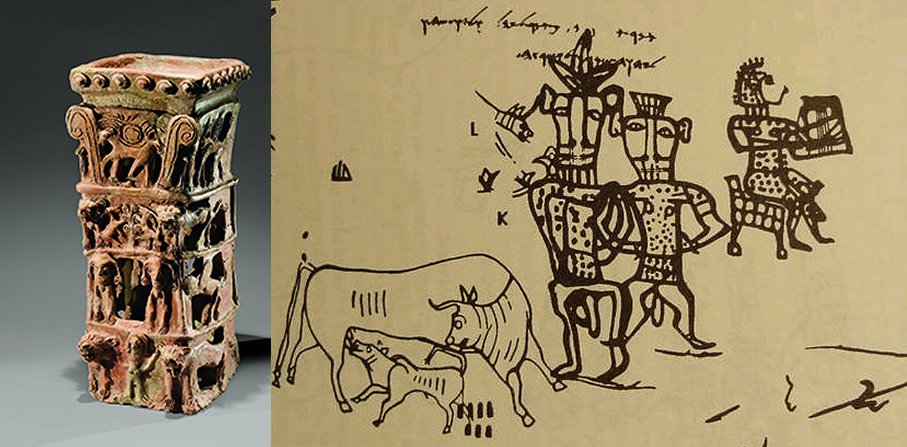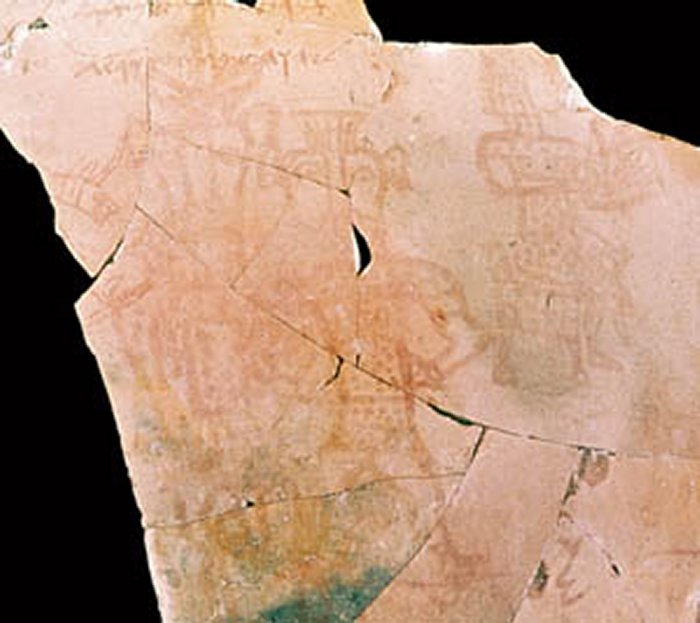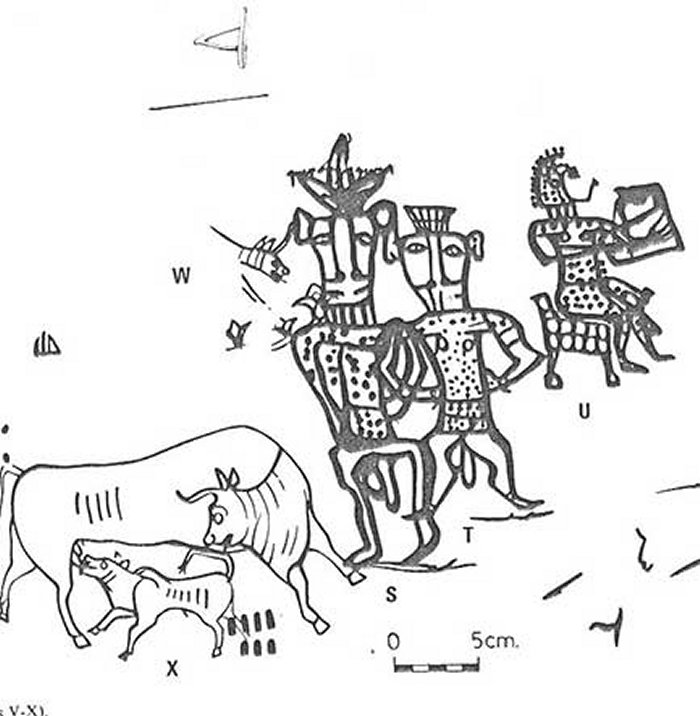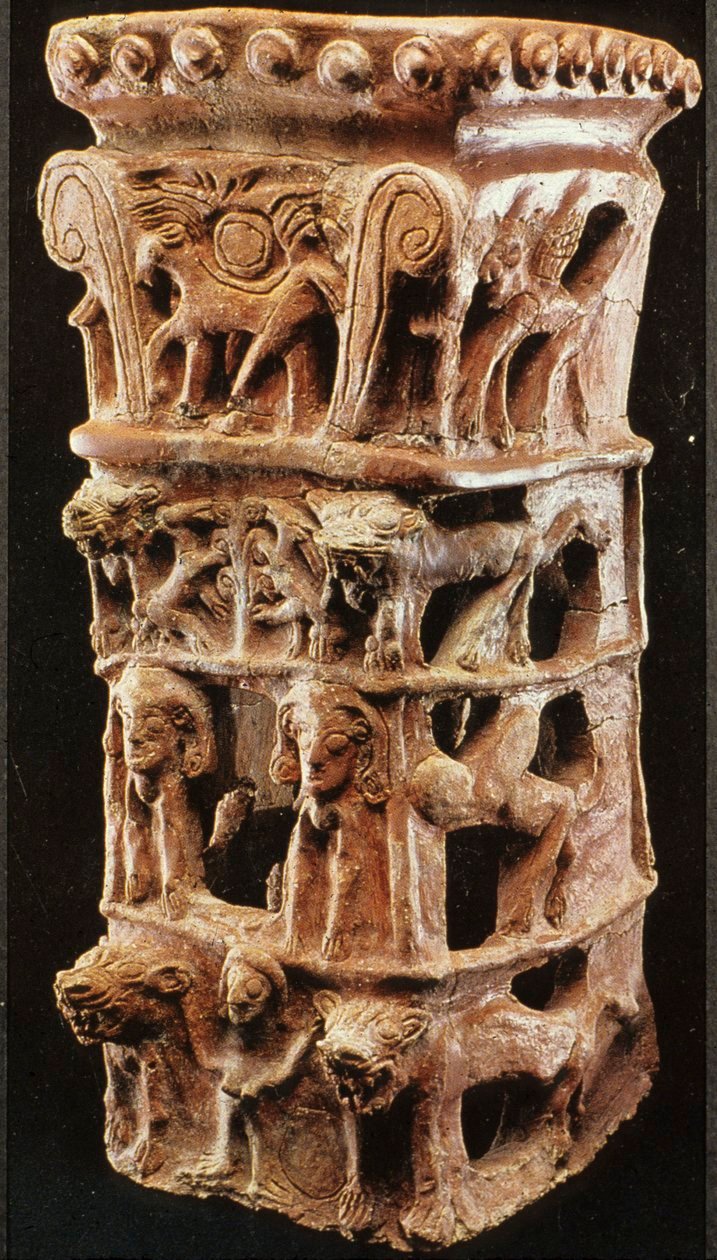Ancient ‘Yahweh And His Asherah’ Inscriptions At Kuntillet ‘Ajrud Remain An Unsolved Biblical Mystery
Ellen Lloyd - AncientPages.com - An ancient drawing and curious inscriptions discovered at Kuntillet ‘Ajrud in the Sinai Desert are intriguing Biblical mysteries that still remain unsolved.
Biblical scholars, historians, and archaeologists have long debated whether the figures found on an ancient drawing storage jar depict Yahweh and his Asherah or someone else.
In 1975, while excavating at Kuntillet ‘Ajrud archaeologists unearthed unique artifacts. Among them were two large pithois, or storage jars, that weighed about 30 pounds each.
“Yahweh and his Asherah” is written across the top of this eighth-century B.C. drawing on a ceramic pithos, or storage jar, from Kuntillet ‘Ajrud in the eastern Sinai. Image credit: Dr. Ze’ev Meshel and Avraham Hai/Tel Aviv University Institute of Archaeology.
Reconstruction of the ancient jars revealed they were painted with animals, symbols, humans, deities, and several inscriptions. It is believed the drawing were made over a considerable period and by several different artists. The iconography is entirely Syrian/Phoenician and lacks any connection to the Egyptian models.
The inscriptions are mostly in early Hebrew with some in the Phoenician script. Many of the inscriptions are religious in nature, invoking Yahweh, El, and Baal.
What created an intense debate are the inscriptions that include the phrases "Yahweh of Samaria and his Asherah" and "Yahweh of Teman and his Asherah.
Who or what was Asherah? The answer to this question depends on scholars’ interpretation of Asherah in relation to Yahweh.
Painted on a jar found in Kuntilat Ajrud in the Sinai Peninsula. Image credit: Unknown Jewish merchant - Public Domain
Some scholars make a distinction between Asherah the goddess and Asherah as a cultic object (sacred pole).
Asherah was a pagan goddess. Was she God’s wife? The term “asherah” is mentioned 40 times in the Bible. It means in Hebrew “happy” or “upright” and some suggest “(sacred) place.”
This four-tiered cult stand found at Tanaach is thought to represent Yahweh and Asherah, with each deity being depicted on alternating tiers. Photo: © The Israel Museum, Jerusalem/Israel Antiquities Authority (photograph by Avraham Hay).
This means that the text on the inscription found at Kuntillet ‘Ajrud can be a reference to a particular goddess, a class of goddess, or a cult symbol used to represent the goddess.
The problem with the inscription on the pithoi becomes even greater because of the drawing depicting two figures that scholars have identified as the Egyptian god Bes, which is in fact a collective name for a group of dwarf deities.
The two figures appear to be depictions of two males and not a drawing of God and his goddess wife.
It is believed that the image was drawn after the inscription was written, so the two may be completely unrelated.
The ancient inscription and the drawing are still subject of a lengthy scholarly discussion as to whether and how the inscription should be interpreted; that is, together with the drawings or independently.
Written by Ellen Lloyd – AncientPages.com
Copyright © AncientPages.com All rights reserved. This material may not be published, broadcast, rewritten or redistributed in whole or part without the express written permission of AncientPages.com
Expand for referencesMore From Ancient Pages
-
 Secrets Of An Ancient Greek City Revealed
Archaeology | Mar 11, 2025
Secrets Of An Ancient Greek City Revealed
Archaeology | Mar 11, 2025 -
 Fossil Teeth Reveal: Humans Were Present In Asia ‘20,000 Years Earlier’ Than Previously Thought
Archaeology | Oct 15, 2015
Fossil Teeth Reveal: Humans Were Present In Asia ‘20,000 Years Earlier’ Than Previously Thought
Archaeology | Oct 15, 2015 -
 On This Day In History: Julian ‘The Apostate’ Died During The Retreat From The Sassanian Empire – On June 26, 363
News | Jun 26, 2016
On This Day In History: Julian ‘The Apostate’ Died During The Retreat From The Sassanian Empire – On June 26, 363
News | Jun 26, 2016 -
 Superior Sword Of Goujian: Jian Weapon And Legend Of Immortal With Good Advice
Artifacts | Oct 15, 2019
Superior Sword Of Goujian: Jian Weapon And Legend Of Immortal With Good Advice
Artifacts | Oct 15, 2019 -
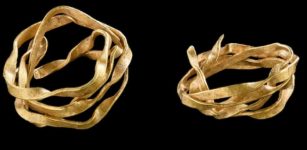 Gold Spiral In Early Bronze Age Grave – Unearthed
Archaeology | Jun 1, 2021
Gold Spiral In Early Bronze Age Grave – Unearthed
Archaeology | Jun 1, 2021 -
 Are The Baffling La Marche Cave Paintings Authentic Or Cunning Forgeries?
Featured Stories | Sep 14, 2020
Are The Baffling La Marche Cave Paintings Authentic Or Cunning Forgeries?
Featured Stories | Sep 14, 2020 -
 Unexplained Encounters With Invisible Barriers – Mysterious Rays And Energy Fields
Featured Stories | Jul 17, 2018
Unexplained Encounters With Invisible Barriers – Mysterious Rays And Energy Fields
Featured Stories | Jul 17, 2018 -
 Magnificent Decorated Tomb Of Scribe Unearthed At Abusir Sheds New Light On Ancient Egyptian History
Archaeology | Nov 8, 2023
Magnificent Decorated Tomb Of Scribe Unearthed At Abusir Sheds New Light On Ancient Egyptian History
Archaeology | Nov 8, 2023 -
 12 Alchemy Symbols Explained
Ancient Symbols | Aug 20, 2018
12 Alchemy Symbols Explained
Ancient Symbols | Aug 20, 2018 -
 Curtana – Sword Of Mercy Once Belonged To The Anglo-Saxon King Edward The Confessor And Perhaps Even The Arthurian Hero Tristan
Artifacts | Jul 16, 2017
Curtana – Sword Of Mercy Once Belonged To The Anglo-Saxon King Edward The Confessor And Perhaps Even The Arthurian Hero Tristan
Artifacts | Jul 16, 2017 -
 How Gold Rushes Helped Make The Modern World
Featured Stories | Aug 1, 2019
How Gold Rushes Helped Make The Modern World
Featured Stories | Aug 1, 2019 -
 Manannán Mac Lir – Irish God Of Sea, Healing, Weather And Master Of Shapeshifting
Celtic Mythology | Mar 2, 2023
Manannán Mac Lir – Irish God Of Sea, Healing, Weather And Master Of Shapeshifting
Celtic Mythology | Mar 2, 2023 -
 Evidence Of Yue – Ancient Chinese Criminal Punishment Found At Sanmenxia City
Archaeology | May 17, 2024
Evidence Of Yue – Ancient Chinese Criminal Punishment Found At Sanmenxia City
Archaeology | May 17, 2024 -
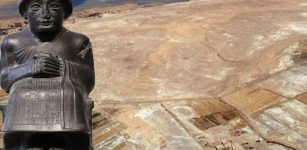 Drone Footage Reveals Ancient Mesopotamian City Lagash Was Made Of Marsh Islands
Archaeology | Oct 14, 2022
Drone Footage Reveals Ancient Mesopotamian City Lagash Was Made Of Marsh Islands
Archaeology | Oct 14, 2022 -
 Unexpected Underwater Discovery Of 50,000 Ancient Coins Off Sardinia Hints At Hidden Shipwreck
Archaeology | Nov 10, 2023
Unexpected Underwater Discovery Of 50,000 Ancient Coins Off Sardinia Hints At Hidden Shipwreck
Archaeology | Nov 10, 2023 -
 Archaeologists Focus On Greek Poet Aratus’ Memorial Tomb And Ruins Of Soli Pompeiopolis
Archaeology | Aug 12, 2020
Archaeologists Focus On Greek Poet Aratus’ Memorial Tomb And Ruins Of Soli Pompeiopolis
Archaeology | Aug 12, 2020 -
 Mysterious Code Hidden In Antique Silk Dress Bought In Maine Finally Deciphered!
Artifacts | Jan 23, 2024
Mysterious Code Hidden In Antique Silk Dress Bought In Maine Finally Deciphered!
Artifacts | Jan 23, 2024 -
 Ancient Roman Sandal With Nails And Game Pieces Found Under A Playground In Germany
Archaeology | Nov 22, 2024
Ancient Roman Sandal With Nails And Game Pieces Found Under A Playground In Germany
Archaeology | Nov 22, 2024 -
 Can This Ancient Underwater Graveyard Solve The Mystery Of The Great Flood And Noah’s Ark?
Archaeology | Oct 23, 2019
Can This Ancient Underwater Graveyard Solve The Mystery Of The Great Flood And Noah’s Ark?
Archaeology | Oct 23, 2019 -
 Vast Network Of Previously Unknown European Bronze Age Megastructures Discovered
Archaeology | Nov 20, 2023
Vast Network Of Previously Unknown European Bronze Age Megastructures Discovered
Archaeology | Nov 20, 2023

